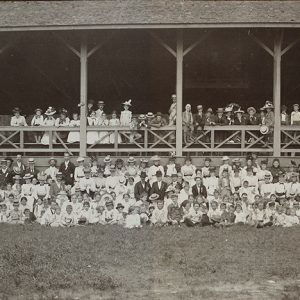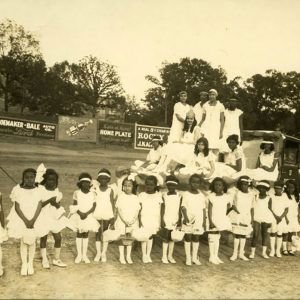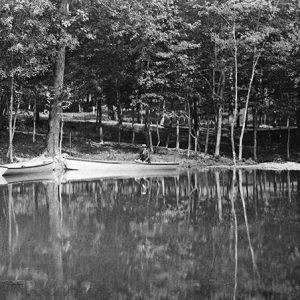calsfoundation@cals.org
West End Park
West End Park was a privately established park in Little Rock (Pulaski County) that opened on May 30, 1885. Created by the Little Rock Street Railway Company, it encompassed a six-block area between 14th and 16th Streets and Park and Kramer Streets. By the late 1920s, much of the land had become the site of what is now Central High School.
The park was the last stop for the Ninth Street Line, which took streetcar passengers to 14th Street, where they walked the remainder of the way and entered the park near the spot occupied in the twenty-first century by the Central High School athletic building. The park boasted the largest grandstand in the state, an artificial lake 250 feet in diameter with an average depth of eight feet, and a bicycle track. Other amenities included walking trails with shaded seating nooks and rare flowers provided by Little Rock florist Tipton & Hurst. Visitors to the park could stroll along the trails or rent boats to paddle around the lake.
From 1885 until the early 1890s, West End Park hosted numerous bicycle races. For example, in one day of racing, a reported 2,000 people were in attendance. This was remarkable given the small size of the city (the U.S. Census counted 13,138 residents in 1880 and 25,874 in 1890). On August 4, 1886, the park hosted a race between John S. Prince, champion bicyclist of America, and Thomas W. Eck, champion tricyclist of Canada. The tournament also included a large number of amateur divisions, based on age, including races for children age ten and under. A number of local bike clubs also participated, including the newly formed Arkansas Traveler bicycle club.
West End Park, with its impressive grandstand, survived for many years. However, at some point in the early 1890s, the enthusiasm for bicycling waned, perhaps overshadowed by the rising popularity of baseball. The crowds that once gathered to watch the racing began gathering instead to watch the newly formed Little Rock Travelers baseball team. The first amateur baseball game was played at the park in 1893, and it remained home to the Little Rock Travelers until Ray Winder Field was opened in 1932. The area was renamed, in 1915, the Kavanaugh Athletic Field, an homage Judge William Kavanaugh, who is credited with bringing minor league baseball to Arkansas and also served for many years as the president of the Southern Association for Minor League Baseball.
By 1907, portions of the park had been sold to the City of Little Rock for $30,000, and by 1927 much of the land had become the site of what is now Central High.
For additional information:
Cole, Monty. “Once upon a Bicycle.” Arkansas Democrat-Gazette, September 16, 2013, pp. 1E, 3E.
“Report on a Park System for Little Rock.” Little Rock: Democrat Printing and Lithography Company, n.d. Online at https://www.loc.gov/item/15025552/ (accessed August 14, 2024).
William L. (Monty) Cole
Little Rock, Arkansas
 Post-Reconstruction through the Gilded Age, 1875 through 1900
Post-Reconstruction through the Gilded Age, 1875 through 1900 Church Picnic
Church Picnic  Kavanaugh Field May Day
Kavanaugh Field May Day  West End Park Bicyclists
West End Park Bicyclists  West End Park, 1890
West End Park, 1890 



Comments
No comments on this entry yet.